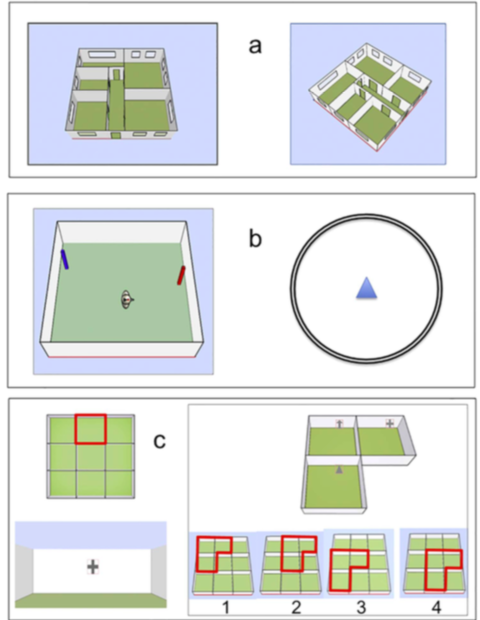
Visualizations play a central role in learning with multimedia. We are interested in dynamic visualizations particularly. Can focused animations (such as dynamic rotation, animated change of spatial perspective and dynamic changes of size and detail through zooming) support the understanding of spatial structures? Does spatial ability affect the understanding of spatial structures when learning with static or with dynamic visualizations?
Wayfinding in real environments is another example. Assistance systems provide dynamic visualizations that help us to navigate successfully. However, acquisition of spatial knowledge beyond the traveled route can be impeded when using navigation assistance. This affects spatial orientation. In our research, we investigate the mental representations of space in human memory. We apply the insights and results of this research to the design of visualizations for navigation assistance systems. We examine whether changes in visualizations have the expected effects on spatial knowledge acquisition in the particular formats of human spatial memory.
Contact: Prof. Dr. Stefan Münzer
A related article: „Gehirn und Geist“ (2015). Link: https://www.spektrum.de/news/schaden-navigationssysteme-unserem-orientierungssinn/1358972
Publications
Münzer, S., Lörch, L., & Frankenstein, J. (in press). Wayfinding and acquisition of survey knowledge with navigation assistance. Journal of Experimental Psychology: Applied
Münzer, S., Fehringer, B.C.O.F., & Kühl, T. (2018). Specificity of mental transformations involved in understanding spatial structures. Learning and Individual Differences, 61, 40–50.
Anacta, V.J., Schwering, A., Li, R., Münzer, S. (2017): Orientation information in wayfinding instructions: evidences from human verbal and visual instructions. GeoJournal, 82, 567–583.
Münzer, S., Fehringer, B.C.O.F., & Kühl, T. (2016a). Standardized norm data for three self-report scales on egocentric and allocentric environmental spatial strategies. Data in Brief, 8, 803–811.
Münzer, S., Fehringer, B.C.O.F., & Kühl, T. (2016b). Validation of a 3-factor structure of spatial strategies and relations to possession and usage of navigational aids. Journal of Environmental Psychology, 47, 66–78.
Münzer, S., & Zadeh, M. V. (2016). Acquisition of spatial knowledge through self-directed interaction with a virtual model of a multi-level building: Effects of training and individual differences. Computers in Human Behavior, 64, 191–205.
Münzer, S. (2015). Facilitating recognition of spatial structures through animation and the role of mental rotation ability. Learning and Individual Differences, 38, 76–82.
Münzer, S.(2012). Facilitating spatial perspective taking through animation: Evidence from an aptitude-treatment-interaction. Learning and Individual Differences, 22, 505–510.
Münzer, S., Zimmer, H. D., & Baus. J. (2012). Navigation assistance: A trade-off between wayfinding support and configural learning support. Journal of Experimental Psychology: Applied, 18, 18–37.
Münzer, S., & Stahl, C. (2011). Learning routes from visualisations for indoor wayfinding: Presentation modes and individual differences. Spatial Cognition and Computation, 11, 281–312.
Münzer, S. & Hölscher, C. (2011). Entwicklung und Validierung eines Fragebogens zu räumlichen Strategien (Development and validation of a self-report measure of spatial orientation). Diagnostica, 57, 111–125.
Münzer, S., Zimmer, H. D., Schwalm, M., Baus, J., & Aslan, I. (2006). Navigation assistance and the acquisition of route and survey knowledge. Journal of Environmental Psychology, 26, 300–308.